Auckland - city on the North Island New Zealand
Auckland is the largest city in New Zealand at 1.7 million citizens, and the main arrival point for visitors to the country. It is a vibrant multicultural city, set around two big natural harbours, and ranked as one of the most liveable cities in the world. It is in the warm northern part of the North Island, on a narrow isthmus that joins the Northland peninsula to the rest of the island.
For information on the smaller towns, settlements and islands in the wider area around the city, see the Auckland Region article.
Districts
Until 2010, the Auckland urban area was divided between four city councils and three district councils. In November 2010, the councils merged into a single "super city" council. The districts here are based on Statistics New Zealand's four Auckland urban sub-areas, which in turn are based on the four erstwhile city councils.
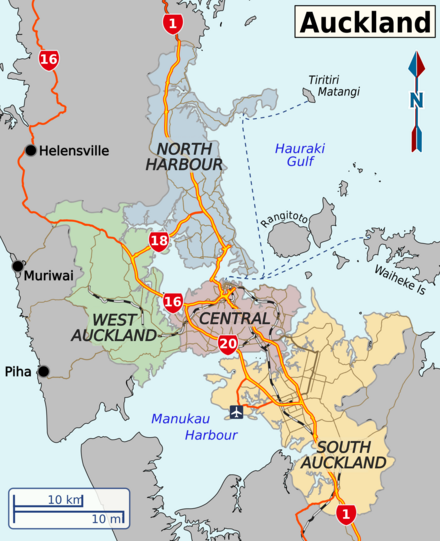
The central business district and central suburbs that made up the former Auckland City. It has many of the main tourist attractions and the bulk of accommodation options.
Stretching from Orewa and the Hibiscus Coast in the north to Devonport on the North Shore in the south, North Harbour has the longest unbroken urban coastline in New Zealand. Devonport, ten minutes by ferry from downtown Auckland, is a popular day trip with its little cafes and Mt Victoria.
The areas south and east of Central Auckland, including Manukau, Howick and Papakura.
Dominated by the Waitakere Ranges, the former Waitakere City offers many of the delights of New Zealand in one area – unique trees and flowers, hiking and wineries – and is the gateway to the West Coast beaches such as Piha and Muriwai.
Understand
 Auckland is New Zealand's largest city, home to 1.5 million people, nearly one-third of the country's population and more than that of the entire South Island. It is the main economic and travel hub and home to an international airport. It's lucky enough to have its own beautiful landscapes, waterways, and other attractions to draw tourists in. It is not New Zealand's political capital though – that honour goes to Wellington.
Auckland is New Zealand's largest city, home to 1.5 million people, nearly one-third of the country's population and more than that of the entire South Island. It is the main economic and travel hub and home to an international airport. It's lucky enough to have its own beautiful landscapes, waterways, and other attractions to draw tourists in. It is not New Zealand's political capital though – that honour goes to Wellington.
Auckland is called the "City of Sails" for the large number of yachts that grace the Waitemata Harbour and the Hauraki Gulf, and for the city's love of sailing. More than 135,000 yachts and launches are registered in Auckland and several America's Cup regattas have been held here. Auckland could also be called the "City of Volcanoes"; much of its natural character comes from being built on the Auckland Volcanic Field, which consists of about 50 volcanoes. All of them are individually extinct (Rangitoto was the latest to erupt, in the mid to late 15th century), but the volcanic field as a whole is not. The city also features a large number of urban beaches and parks, numerous arts and cultural institutions and events, and is home to a multitude of sporting teams.
Auckland is frequently ranked highly in international quality-of-life polls, including third in Mercer's Quality of Living Ranking (behind Vienna and Zurich). However, Auckland is also New Zealand's most expensive city – house prices alone are double to triple those found in Wellington, Christchurch and Hamilton (the latter 130 km away).
Alias Wang and Li
Auckland's multiculturalism is strongly being reflected at the birth registry office. In 2013, the most common surnames of newly born Aucklanders were Wang, Li, Chen, Liu, Smith, Zhang, Lee, Patel, Huang and Singh.
Auckland is very multicultural, with strong immigrant cultures. Some 40 percent of Auckland's population was born overseas; in two local board areas, Puketapapa (Mount Roskill) and Howick, there are more overseas-born residents than New Zealand-born ones. It has the largest Polynesian population of any city in the world. For some Polynesian island nations, there are more expatriates living in Auckland than in their homeland. There is also a large population of New Zealand's native Maori people, and populations of immigrants and expats from the UK, China, India, South Africa, South Korea and the Philippines, among others. Auckland's rich cultural mix is celebrated with a wide variety of festivals and events throughout the city.
Climate
Auckland by definition has a temperate climate, although it is often regarded by New Zealanders as having a subtropical climate. The city experiences four distinct seasons with warm summers and mild winters. Winter night temperatures rarely fall below 0 °C. Auckland experiences regular rainfall throughout the year, with more in winter than summer, though it can also have periods of drought. Snow in Auckland is extremely rare – the last decent snowfall in the city was in the 1930s, although snow flurries occurred in 1976 and 2011.
Get in
By plane
Main article: Auckland Airport
Auckland Airport, -37.002°, 174.789°. (IATA: AKL). New Zealand's largest airport is located 22 km/14 miles south of central Auckland in the southern suburb of Mangere on the shores of the Manukau Harbour. There are frequent services from Australia and other New Zealand cities. There are also non-stop flights from locations in Asia, the Pacific Islands, the United States, Vancouver (Canada) and Santiago (Chile). Ground transport options from the airport to central Auckland include shuttles (NZ$35) and taxis (NZ$35-65 ask for fixed fare; NZ$75-90 metered). For public transportation, you can buy a HOP card for $10 at the airport and take the AIR bus from Stop A International Terminal, get off at Puhinui Train Station, then board a train to Britomart Train Station in the CBD; the journey will take 60-90 minutes including waiting times depending on the time of the day.
North Shore Aerodrome, -36.657°, 174.653°. Has a few flights from Kerikeri in the Bay of Islands, Tauranga and Great Barrier Island.
By bus
The InterCity Sky City Bus Terminal at 102 Hobson St (behind Sky City Plaza) is the main hub for national coachline InterCity and its subsidiaries GreatSights and Skip Bus. Facilities include an InterCity ticketing office, free Wi-Fi, café and luggage lockers.
By train
Main article: Rail travel in New Zealand
The Northern Explorer train runs from central Wellington to Auckland Strand Station 📍 on Ngaoho Place, in eastern central Auckland. The 681-km (423-mi) journey takes about 12 hours. The trip runs much of the length of the North Island with stopping-off opportunity at Tongariro National Park. In a single day you will pass every kind of scenery: coastline, volcanoes and mountains, green farm pastures and dense New Zealand bush. The train leaves Wellington on Tuesday, Friday and Sunday, and returns from Auckland on Monday, Thursday and Saturday.
Additionally, there are daily regional services from Hamilton with the Te Huia passenger service. The service is mainly aimed at commuters.
By car
Auckland is accessed from the south via State Highway 1. From Hamilton and New Plymouth you'll follow State Highway 1 north of Hamilton through northern Waikato and across the Bombay Hills into the southern suburbs of the city. From Tauranga and the Bay of Plenty, you'll follow State Highway 2 west of Tauranga to meet State Highway 1 at Pokeno, on the Waikato side of the Bombay Hills. From most other points south (including Rotorua, Napier, Palmerston North and Wellington), you will travel north to Tirau in the southern Waikato where you can choose between two routes; via Hamilton along State Highway 1, or via Matamata along State Highways 27 and 2.
From Northland, you'll follow State Highway 1 to Wellsford. From there, you can continue to follow State Highway 1 to approach Auckland through the northern suburbs and over the Auckland Harbour Bridge. Alternatively, you can follow State Highway 16 to approach Auckland from the northwest via Helensville.
Approximate distances and non-stop travel times to Auckland:
- Whangarei – 160 km, 2 hours
- Hamilton – 125 km, 1.5 hours
- Rotorua – 230 km, 2.75 hours
- New Plymouth – 360 km, 4.5 hours
- Napier – 415 km, 5 hours
- Wellington – 650 km, 8 hours
By ship

To get beyond the CBD, look for a bus called "The Link". The red city LINK bus runs along Queen Street and is only $1. The Link bus will always end up back at the place you started so you can never get lost - stay on the bus and see it all for one low flat fare. Explorer runs a hop-on, hop-off bus service. Taxis are relatively plentiful; many, such as those that serve the airport, accept credit cards.
Get around
Local transport options include bus, train, ferry, shuttle, taxi, and car rental. Use the Auckland Transport (AT) website to plan trips by public transport. AT also has a text messaging service that can be used to find the time of the next bus, ferry or train or to find the quickest way to get to your destination using public transport, as well as apps for iPhone and Android. If you wish to do a lot of cross-city travel, or travel outside the city, it may be more convenient to hire a car, though some city roads are congested at peak times.
Britomart Transport Centre on the corner of Queen St and Customs St in the CBD near the waterfront is the main information centre for public transport. You will find free bus, train and ferry schedules there – which is handy since the frequency of some services is low and sometimes irregular. Timetables can also be downloaded from the AT website.
The AT HOP card is a prepay smart card for travel on bus, train and ferry services that costs $10. It gives free transfers and a significant discount off single trip adult cash fares, except for Airbus and NiteRider buses and Waiheke ferries. Bus and train fares use a zone-based system: fares start at $3.50 cash or $2.00 AT HOP for within-zone journeys. There is a $20 daily fare cap on trains, buses and inner harbour ferries. Or you can save $2 by buying a Day Pass for $18.
For frequent travel on buses and trains, monthly passes can be loaded on a HOP card. These allow you to take unlimited bus and train rides. You must tag on and tag off each trip. A monthly pass pass for the entire network costs $215.
By bus
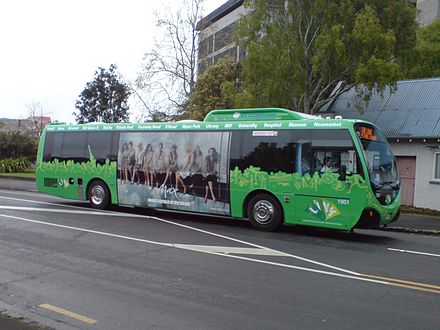 Bus services cover most areas of Auckland. Between 2015 and 2018, the bus network was significantly overhauled, simplifying routes and extending frequent bus services, with the trade-off of having to transfer to a train, ferry or another bus to access the CBD from the outer suburbs. Routes with two-digit numbers run at least every 15 minutes daily between 7AM and 7PM; routes with three-digit numbers operate on lower frequencies.
Bus services cover most areas of Auckland. Between 2015 and 2018, the bus network was significantly overhauled, simplifying routes and extending frequent bus services, with the trade-off of having to transfer to a train, ferry or another bus to access the CBD from the outer suburbs. Routes with two-digit numbers run at least every 15 minutes daily between 7AM and 7PM; routes with three-digit numbers operate on lower frequencies.
The most useful bus routes for visitors are as follows:
- The City Link bus runs in a circuit from Karangahape Rd/Upper Queen St to Britomart or the Wynyard Quarter – it costs $1 cash or 50c with HOP (as of October 2016).
- The Inner Link is a loop service connecting CBD and the surrounding areas of Newmarket, Parnell and Ponsonby. It is fairly frequent and costs up to $3 paying with cash or $1.80 with HOP card.
- Northern Express (NX1 and NX2) buses run between the central city and the North Shore along the Northern Busway, a bus rapid transit (BRT) line. NX1 services start at Lower Albert St near Britomart and terminate at Hibiscus Coast busway station. NX2 services start in Wellesley St between the universities and terminate at Albany busway station. They run every 3 to 10 minutes during working hours and no more than 15 minutes apart in the evenings and weekends. Last services leave between 11PM and midnight, with some NX1 services after midnight on Friday and Saturday nights (but only to/from Albany, not Hibiscus Coast).
- The Tāmaki Link runs every 15 minutes between Britomart, St Heliers and Glen Innes train station via Tamaki Drive, passing by Kelly Tarlton's.
- Route 18 provides a service every 12 minutes between Victoria St in the CBD and New Lynn train station, via Great North Rd, passing close to the Zoo and MOTAT.
By train

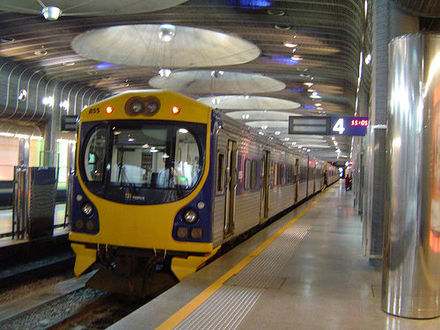 Travel by urban train is a good option, but only if you are near a train line; there are few lines and not all suburbs are served. Rail in Auckland has had a renaissance since the turn of the millennium, especially after the central city terminus moved to Britomart in 2003. During 2014 and 2015 new electric trains replaced diesel trains, except between Papakura and Pukekohe in the south, where diesels still run.
Travel by urban train is a good option, but only if you are near a train line; there are few lines and not all suburbs are served. Rail in Auckland has had a renaissance since the turn of the millennium, especially after the central city terminus moved to Britomart in 2003. During 2014 and 2015 new electric trains replaced diesel trains, except between Papakura and Pukekohe in the south, where diesels still run.
An AT HOP card provides tag-on/tag-off travel.
The four main lines are the Southern, Onehunga, Eastern and Western lines. The Southern Line runs from Britomart station in the CBD, roughly parallel to the Southern Motorway, to Papakura, with some services continuing on to Pukekohe. The Onehunga Line follows the Southern Line as far as Penrose, before diverting southwest to Onehunga. The Eastern Line runs from Britomart through the east of central Auckland to Manukau Central, sharing with the Southern Line between Westfield and Puhinui. The Western Line runs from Britomart westward to Swanson station. There are no train services in North Harbour or in the suburbs east of the Tamaki River, although the Northern Express bus (see By bus above) from Britomart to Albany provides rapid transit service to the rail-less North Shore.
The Southern and Eastern lines have the most frequent and reliable services. Trains on these lines run every 10 minutes on-peak, 20 minutes off-peak and 30 minutes on evenings and weekends. Approximately 85-95% of these services run on time. Trains on the Western Line run every 15 minutes on-peak, and every 30 minutes off-peak and on weekends. The Onehunga Line runs every 30 minutes all day every day.
By car
The road network experiences severe congestion at rush hour. Geography constrains the network to a limited number of routes. Auckland has a comprehensive road network for a city its size, but lack of investment in public transport and geographic sprawl means it is largely dependent on private cars.
It is often easier and cheaper to hire a car instead of using taxis, simply because the city is so large and spread out. Auckland city is well covered by the main global car rental companies, such as Avis, Budget, Hertz, Thrifty and Europcar. All car rental companies offer competitive pricing for economy class vehicles and unlimited mileage options. Local car rental companies like Apex and Jucy may also offer competitive pricing.
There are three main motorway systems running through Auckland. The Northern Motorway (from north of Orewa to the Central Motorway Junction (CMJ) a.k.a. Spaghetti Junction) – note that it has a toll for the last few kilometres beyond Silverdale. The Southern Motorway runs from the CMJ past the Bombay Hills where it splits into State Highway 2 (SH2), and merges to the Waikato Expressway. The Northwestern Motorway runs from Auckland Port through CMJ to near Kumeu. These motorways clog up during the morning rush in the CBD-bound direction, and in the opposite direction during the evening rush. The Harbour Bridge has a method of mitigating this traffic load – it changes the lane system from 4-4 to 5-3, favouring the side which has the heavier traffic load. So be careful when crossing the bridge – some lanes will be available for you at one time but not another.
Watch heading southbound over the Harbour Bridge – if you are heading to the Southern Motorway (e.g. to South Auckland or the Airport), make sure you are in at least lane 3 (if not lane 4) before you reach the bridge to ensure you go over on the main bridge and not the clip-on lanes. Otherwise you will have only a few hundred metres after the bridge to cross two lanes of traffic to lane 4 before lane 1, 2 and 3 split off towards the city centre and the Northwestern Motorway.
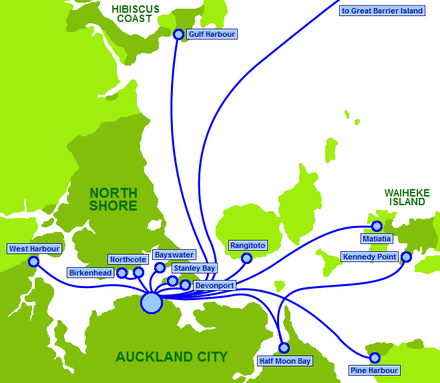 Some motorway on-ramps have traffic lights operating in busy periods – they allow one or two cars to proceed every three to eight seconds to ease the merging onto the motorway. Cameras may be operating to catch red-light runners.
Some motorway on-ramps have traffic lights operating in busy periods – they allow one or two cars to proceed every three to eight seconds to ease the merging onto the motorway. Cameras may be operating to catch red-light runners.
By taxi
Taxi fares vary considerably from company to company. For example, see the Get in: By plane section for an indication of fares from the airport to Britomart.
The Uber ride-sharing service is available in most of Auckland, and local service Zoomy is available in much of central Auckland.
By ferry
Ferry services operate from the CBD to other points on the mainland and to Hauraki Gulf islands.
See
 Auckland's many volcanoes offer great vantage points to take in the city and some of them have been turned into parks. Popular ones include Mt. Eden and One Tree Hill in Auckland Central and Mt. Victoria in Devonport.
Auckland's many volcanoes offer great vantage points to take in the city and some of them have been turned into parks. Popular ones include Mt. Eden and One Tree Hill in Auckland Central and Mt. Victoria in Devonport.
- Auckland Art Gallery, cnr Kitchener and Wellesley Streets. The largest collection of national and international art in New Zealand, housed in an award-winning landmark building on the edge of Albert Park in the heart of Auckland. The Gallery regularly hosts touring international exhibitions and offers a calendar of talks, performances, film screenings and children's activities to complement its exhibition programme. Has a shop and café. Free entry to permanent exhibitions for locals (excluding special exhibitions), $20 for international visitors
- Auckland Domain is Auckland's oldest park and hosts weekend sports events. Includes the historically important winter gardens with impressive flower bed displays, tropical plants and statues (free). There are scenic views of the Waitemata Harbour and islands of the Hauraki Gulf from in front of the museum.
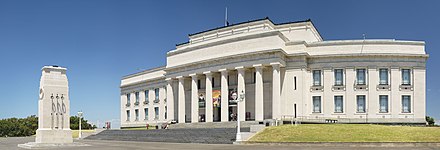
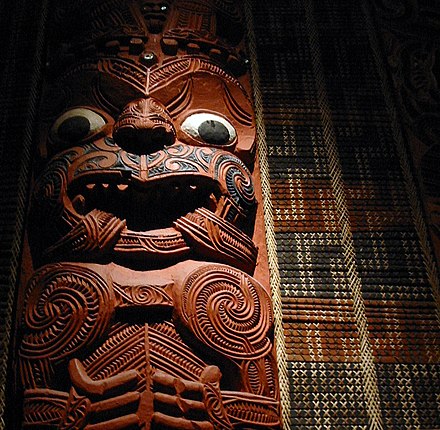
- Auckland War Memorial Museum, Parnell. The museum displays collections of significant importance at its prominent position in Auckland Domain. It was constructed in the 1920s as a war memorial to those that fought and died in theatres of war. The cenotaph located on the grounds below the steps leading up to the museum entrance is the focal point for annual ANZAC day remembrance services. The top floor records names in stone as well as sobering tombs and lists of war events and their locations. The museum contains excellent exhibitions of Māori and other Polynesian peoples' arts and crafts and daily Māori cultural performances as well as geography of the Auckland region. There is a planetarium and a cafe. $25 entry for overseas visitors, donation invited from NZ residents, free for Auckland residents.
- Auckland Zoo, Motions Rd, Western Springs. Auckland Zoo is home to the largest collection of native and exotic animals in New Zealand, set in 17 hectares of lush parkland and just minutes from central Auckland.

- Kelly Tarlton's Sea Life Aquarium on the scenic Tamaki Drive includes the Antarctic Encounter and Underwater World. It's an aquarium that includes a trip through a transparent tunnel while the fish and sharks swim all around you, and tanks of rays with feeding-time talks.
- MOTAT (Museum of Transport and Technology), Great North Rd, Western Springs. Situated near the Zoo in Western Springs. It's an interactive museum with over 300,000 items. Look out for the WW 2 Avro Lancaster Bomber and the Solent Flying Boat in the Sir Keith Park Memorial Aviation Collection.
- New Zealand National Maritime Museum, cnr Quay and Hobson St, Viaduct Harbour. Interesting exhibits chronicle New Zealand's maritime history. Free entry for Aucklanders, $20 for other visitors.
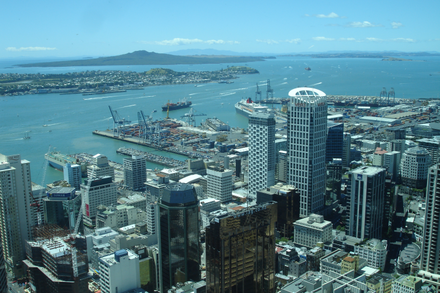
- Sky Tower, cnr Victoria and Federal St. At 328 m, this is the tallest free-standing tower in the Southern Hemisphere, offering views of up to 80 km away and fine dining in the Orbit revolving restaurant.
- The StarDome Observatory on the slopes of One Tree Hill. The park also contains Māori archaeological sites, a kid's playgrounds, two cafes and a working farm.
Do
- Movies. Ticket prices vary around Auckland. The cheapest are in the west, with adult tickets at WestCity in Henderson the lowest at $8.50, and a bit higher at $10 at LynnMall and Westgate. Hoyts Hibiscus Coast in the north on Whangaparaoa Peninsula is also cheap at $10.90. Elsewhere in Auckland prices are in the $18.50 to $19.50 range, except on Tuesdays when there is a $12.50 special (2017 prices).
- Visit the Waitakere Ranges in West Auckland, replete with impressive waterfalls and rugged but beautiful beaches. Around 45 min (peak hours) drive from central Auckland.
Beaches
There are many beaches, due to Auckland's straddling of two harbours. The most popular ones are in three areas:
- North Shore beaches (in North Harbour district) are on the Pacific Ocean and stretch from Long Bay in the north to Devonport in the south. They are almost all sandy beaches with safe swimming, and most have shade provided by pohutukawa trees. Most are accessible by bus. Takapuna Beach is the most centrally located, with a lovely beach-front café at one end. Just north of Long Bay is a family nudist beach. St Leonard's Beach is gay male nudist. Others are conventional.
- Tamaki Drive beaches are on the Waitemata Harbour, in the upmarket suburbs of Mission Bay and St Heliers in Central Auckland. These are sometimes-crowded family beaches with a good range of shops lining the shore. Swimming is safe. Mission Bay beach is Auckland's equivalent of Los Angeles' Santa Monica/Venice Beach and is extremely popular on a hot summer's day. To its east, Kohimarama and St Heliers beaches are usually less crowded. Ladies Bay to the east of St Heliers has historically been a nudist-friendly beach, but is frequented by regular beachgoers too, and is accessible by a 5 min walk down from the cliff-top road.
.jpg/440px-Piha_Beach_(7187457994).jpg)
- West coast beaches are on the Tasman Sea, and have large expanses of sand and rolling surf. They have unpredictable rips so you should swim only between the lifeguards' flags, which cover select areas of the most popular beaches. They are about a 40-min drive from the city centre (via West Auckland) and the roads are narrow and winding. You'll need your own transport. There's little shade available, and few shops. The sand on these beaches is dark in colour due to high iron content from its volcanic origins. There are several smaller beaches accessible only by foot. The major beaches from south to north are:
- Whatipu is the southernmost beach, and the most isolated. The last 7 km of the road there is unsealed, but in good condition. There's a track from the carpark to the beach conservatively signposted as 15-min walk. There are several volcanic outcrops surrounding the beach, and native vegetation including cabbage trees along the path. Manukau Harbour is just to the south of the beach, separated by Paratutae Island. Paratutae is joined to the beach except at high tide. There are caves signposted 20-min walk from the car park; the track is muddy during winter. The caves are less spectacular than they once were because they've partially filled up with sand. No dogs are permitted.
- Karekare is the next beach north of Whatipu. It's considerably more popular and there are lifeguards patrolling the beach during summer. Karekare Falls is a waterfall not far from the road.
- Piha is the best known and most popular beach. It has lifeguards during summer. The most notable feature is Lion Rock, which separates the northern and southern sides of the beach. There's a steep track partway up Lion Rock to get decent views. Kitekite Falls are a small and pleasant waterfall near the beach. Laird Thomson Track is a walkway from North Piha to the isolated Whites Beach, which usually has very few people on it.
- Anawhata has no road access to the beach, but there's a fairly steep track down from an unsealed road. This is the least used beach and you may be the only people there at any given time.
- Te Henga (Bethells Beach) is accessible by road, and has lifeguards in the summer. Erangi Point separates it from unpatrolled O'Neill Bay to the north, which can only be reached by foot.
- Muriwai is the second most popular of the west coast beaches. There's a colony of gannets (seabirds) which nest in huge numbers and are worth seeing year round. Muriwai has a café, a golf course, and lifeguards during summer.
Buy
The downtown area of the CBD has a number of souvenir shops for a range of budgets. Check around the lower Queen Street and lower Albert Street area.
Hobson Street (at the top end) has a couple of large shops also stocking honey and health products.
The High Street/Vulcan Lane/O'Connell Street area is the Fashion centre of Auckland Central and has local designer stores as well as international brands
There are a number of markets in Auckland; perhaps the most famous for Aucklanders are the Otara and Avondale markets (serving South and West Auckland respectively).
Eat
There are some good cheap food courts (food halls) offering a variety of usually Asian foods usually priced around $10. Try next to the Queens' Arcade at the bottom of Queen St (slightly hidden entrance), or the Metro award winning Food Alley (9-11 Albert St). Very good value and good quality predominantly non-Asian choices are available at Elliott Stables (39 Elliott Street, near Wellesley). Also on the same block is the Atrium on Elliott (21 Elliott Street), a good quality food court of predominantly Asian food. Check out the once-a-week night markets at various locations on different nights.
Britomart Precinct on the waterfront in the city centre is home to an array of popular and diverse bars and eateries. Cafe Hanoi, Ebisu, Britomart Country Club, Mexico Giapo ice cream, to name a few. A must visit.
Viaduct Harbour provides upmarket dining, starting at $30 for mains. While this area has some very nice bars and restaurants, be wary of restaurants lacking customers and usually very quiet. It may be a sign of below average food or poor service.
Drink
 You can find neighbourhood pubs in many parts of the city, but the highest concentration of bars and clubs is in Auckland Central — particularly around the Viaduct area, K Road, Ponsonby and Parnell.
You can find neighbourhood pubs in many parts of the city, but the highest concentration of bars and clubs is in Auckland Central — particularly around the Viaduct area, K Road, Ponsonby and Parnell.
Learn
Auckland is home to the University of Auckland, which is the top ranked university in New Zealand, and is consistently ranked among the top 100 in the world by several ranking agencies.
Work
Due to already high migration and stresses on local infrastructure in Auckland, the New Zealand immigration service makes it harder to obtain a work visa for those migrants wishing to work in Auckland. Australian citizens and permanent residents can live and work in New Zealand indefinitely.
Sleep
Accommodation can be found throughout the city, but the largest selection is in Central Auckland particularly the central business district.
Backpackers hostels are predominantly found in the central business district although there are a few in other areas. These are usually intended for young adults coming from overseas but there are few, if any restrictions on who can stay. Beds in shared dorms will cost around $40-$60 per night, female only dorms are also commonly offered. Often, they will also offer private rooms for a premium but these will be more competitively priced than a hotel room in a similar area. They will usually have a shared kitchen, and various other shared facilities such as games and TV rooms but this will vary from hostel to hostel.
Motel style accommodation is found across the city, they will almost always have car parking available and a reasonably well equipped kitchenette in each room. These are often less expensive than hotels of similar quality and provide the ability to self-cater. They may have shared facilities such as games and tv rooms or occasionally pools or spas.
Traditional hotels are found mainly in the CBD although there may be others in areas with a high density of offices to cater to people on work trips. These are often the most expensive type of accomodation. Quality can vary from just adequate to luxury.
Airbnb can offer a range of accommodation to suit any size group and budget and often has locations outside of traditional accomodation spots. Hosts are usually welcoming and friendly, although they may prefer to "leave a key" and not interact face to face.
Stay safe
Auckland is a safe place to visit, thanks to a quality of life that ranks alongside cities like Munich or Melbourne. That said, thefts and robberies are more prevalent than in the rest of New Zealand, and aggravated assaults are not unheard of. Make sure to take all the usual safety precautions. Asking locals can give you an idea of where not to go.
The area locals will most definitely warn you about is South Auckland, which is widely regarded as one of New Zealand's most dangerous locations due to its significant poverty and unemployment rates. While it is nowhere nearly as dangerous as "rough" areas in the USA or Europe, it is advised to remain on one's guards at night. People might also advise against going to certain parts of West Auckland, a former working-class area seen as "rough around the edges" that has thankfully improved markedly over the years, but still suffers from occasional burglaries and thefts.
As in the rest of the country, alcohol culture is very prevalent in Auckland, and it is not abnormal to see drunkards of all ages and from all walks of life meander around.
Drugs are also becoming a major issue in Auckland, with junkies becoming an unfortunately common sight along Karangahape Road (commonly known as K' Road) and parts of Queen Street at night. Simply avoiding eye-contact will be enough to avoid trouble.
Connect
There are many internet cafes in the CBD with prices ranging from $1 per half an hour to $5 per hour. Free internet is available from the public library (limited 100MB per IP address per day). There is also free Wi-Fi in the Skycity food courts. There are 40 HotSpots that offer Wi-Fi connectivity, most notably Esquires cafe (inside Skycity Queen St, Middle Queen St, Lower Queen St, Nelson St), Starbucks (Victoria St, K' Rd, Lower Queen St) and other cafes around Auckland.
Cope
Consulates
- 🇦🇺 Australia, Level 7 PriceWaterHouseCoopers Tower 186-194 Quay Street, +64 9-921 8800, consular.auckland@dfat.gov.au. M-F 9AM-12:30PM and 1-4PM, closed Sa Su.
- 🇦🇹 Austria, 22a William Pickering Drive, North Harbour, +64 9 476-0994, austrianconsulate_auckland@xtra.co.nz. M-Th 10AM-noon by appointment. Honorary Consulate-General - the embassy is in Canberra, Australia. Accepts applications for new passports and identity cards but can not issue emergency travel documents. This consulate deals with Northland, Auckland, Waikato, Bay of Plenty regions and there are other honorary consuls in Wellington and Christchurch.
- 🇧🇩 Bangladesh, Apartment 7P Harvard on Hobson, 147 Hobson St, +64 9 302-0545, +64 21 793 495 (Mobile), ataurrahman@xtra.co.nz.
- 🇧🇧 Barbados, 19 Vaughan Rd, Okura, RD2, Albany, +64 9 473-5949, FredWatson@xtra.co.nz.
- 🇨🇳 China, 588 Great South Rd, Greenlane, +64 9 525-1588, chinaconsul_ak_nz@mfa.gov.cn. M-F 9AM-noon & 2-4PM.
- 🇬🇷 Greece, 108 Paihia Rd, One Tree Hill, +64 9 571-0238, nikosp@xtra.co.nz. M-F 9AM-4PM.
- Taipei Economic and Cultural Office, Level 18, 120 Albert St, +64 9 303-3903, tecoakl@taiwan-roc.org.nz.
- 🇺🇸 United States of America, Level 3, Citigroup Building, 23 Customs Street East, +64 9 303 2724, aucklandacs@state.gov.
Go next
- Go wine tasting on Waiheke Island. It's home to an abundance of art galleries, some fantastic wines and has some of the best beaches in the area. You can rent a scooter and get around the island fairly quickly. Can get crowded during the weekends, but very quiet during the week. It seems a world away from Auckland, but is only 35 minutes by ferry.
- Take a ferry to Rangitoto Island. Rangitoto Island has trails around much of the island, as well as a bridge that connects to the neighboring Motutapu Island, and is a great hike for even the most inexperienced hikers. Rangitoto Island has several lava caves that can be crawled or climbed through as well a spectacular 360 degree view at the summit (only about an hour hike on the most direct trail). This is one of the more convenient islands that is nearby as it is only 20-25 minutes by ferry.
- Rotorua, Hamilton, Waitomo Caves and Taupo are all within several hours drive and all have a lot to offer.
Auckland
aucklandcouncil.govt.nzAuckland
2nd-order administrative division
Auckland Region
Primary administrative division